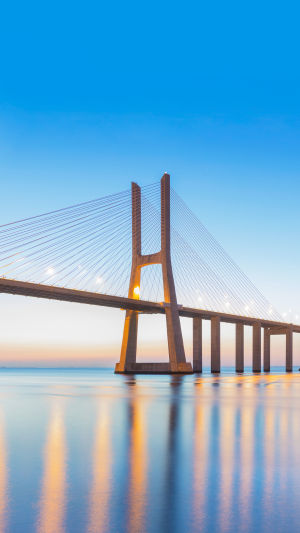The Vasco da Gama Bridge, stretching gracefully across the Tagus River, is not only a vital connection between northern and southern Portugal but also an architectural marvel.
Located in Lisbon, this iconic bridge is one of the longest in Europe, offering travelers a stunning view of the city’s skyline and the vast expanse of the Tagus River.
<h3>Entry and Access Information</h3>
There is no specific entry fee to access the Vasco da Gama Bridge, as it is a public road. However, travelers driving across it should be aware of the toll fees, which vary based on vehicle type. For a standard car, expect to pay approximately €2.85 for a one-way trip. The bridge is open 24 hours a day, making it a convenient route at any time.
While the bridge is primarily for vehicular traffic, there are scenic spots on both ends where Lykkers can park and take in the views. For those interested in seeing the bridge without driving across, the nearby Parque das Nações area offers beautiful viewpoints, particularly during sunset.
<h3>History and Significance</h3>
The Vasco da Gama Bridge was completed in 1998 to commemorate the 500th anniversary of Vasco da Gama's voyage to India, an event that helped Portugal establish itself as a powerful maritime nation. This engineering feat is over 12 kilometers long, making it one of the longest bridges in Europe. Its construction played a crucial role in reducing traffic congestion around Lisbon by providing an alternative to the older 25 de Abril Bridge.
The bridge’s name pays homage to one of Portugal’s most famous explorers, Vasco da Gama, whose pioneering sea routes expanded Portugal’s influence across the globe. As Lykkers travel over this stunning structure, it’s easy to reflect on the bold spirit of exploration that defined Portugal's history.
<h3>Best Time to Visit</h3>
The Vasco da Gama Bridge is an impressive sight any time of day, but it’s particularly stunning at sunrise and sunset. During these golden hours, the sky reflects beautifully on the water, casting warm hues over the bridge's sleek architecture. For Lykkers visiting Lisbon, timing a visit to the nearby Parque das Nações at dusk provides a perfect opportunity to witness the bridge illuminated as the sun dips below the horizon.
Spring and fall are the best times to visit Lisbon, as the weather is pleasant, and crowds are thinner compared to the busy summer months. During these times, temperatures range between 15°C to 25°C (59°F to 77°F), perfect for outdoor sightseeing and leisurely drives.
<h3>Getting There and Nearby Attractions</h3>
The Vasco da Gama Bridge connects the northern and southern parts of Portugal’s A12 highway, making it easy to access from various points around Lisbon. From Lisbon’s city center, the drive to the bridge takes around 20 minutes via the A2 and A12 highways.
Public transportation does not run across the bridge, but the surrounding areas are well connected by buses, trains, and the metro system. Lykkers staying in central Lisbon can take a short trip to Parque das Nações, an urban area developed for the 1998 Lisbon World Exposition, offering stunning views of the bridge. The area also features attractions such as the Lisbon Oceanarium and the Vasco da Gama Tower.
<h3>Tips for Visiting the Bridge</h3>
<b>Best Views</b>: For breathtaking photos of the Vasco da Gama Bridge, head to the Parque das Nações promenade. This area offers unobstructed views of the bridge and the Tagus River. For an elevated view, the cable car ride in Parque das Nações provides an even more dramatic perspective.
<b>Cycling and Walking</b>: While the bridge is not designed for pedestrian or cycling traffic, the surrounding areas in Parque das Nações are perfect for a leisurely walk or bike ride along the riverfront. This is an ideal way to soak in the beauty of Lisbon's modern architecture.
<b>Driving Across</b>: If Lykkers plan to drive across the bridge, consider taking a day trip to southern Portugal. The scenic drive takes you through charming towns and coastal areas, allowing for a pleasant journey as you cross the Tagus River.
<h3>Practical Considerations</h3>
For Lykkers planning a trip to the Vasco da Gama Bridge, it’s important to remember that while the bridge itself is free to access, the toll fees apply to all vehicles crossing it. Depending on your itinerary, it may be more economical to visit the bridge by viewing it from nearby Parque das Nações.
When driving, GPS systems will automatically direct you to the nearest access point for the bridge. Be mindful that during peak hours, there may be heavy traffic, especially around Lisbon’s city center.
<h3>Final Thoughts</h3>
The Vasco da Gama Bridge is more than just a means of crossing the Tagus River—it’s an architectural symbol of Lisbon’s modernity and Portugal’s rich history of exploration. Whether driving across it, admiring it from the shore, or taking photos as the sun sets over the horizon, this landmark is a must-see for any Lykkers visiting Lisbon. With its stunning views, historical significance, and strategic importance, the Vasco da Gama Bridge stands as a testament to Portugal’s forward-looking spirit.





